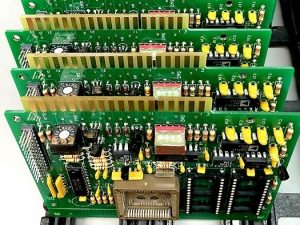Conformal Coating Applications: Liquid vs Parylene
Posted by Sean Horn
Friday, January 19, 2018 7:10
@ 7:10 AM
Conformal coating of an object occurs when an appropriate coating material is applied on-top and around an underlying substrate, to protect it from such environmental and performance concerns as chemical incursion and excess moisture. Liquid organic polymer conformal coatings – acrylic, epoxy, silicone and urethane – prevent:
- board contamination from external chemicals, grit and related substances,
- corrosion of internal solder, copper, and other metal surfaces.
- current leakage, and
- electrical failure.
 Liquid coatings also reduce the incidence of arcing, conductive anodic filament (CAF) formation, corona discharge, metal migration and tin whisker growth. Further support is offered through dielectric insulation and mechanical improvement of solder joints’ fatigue life, while protecting components from mechanical shock, excessive temperature fluctuations and extreme vibration.
Liquid coatings also reduce the incidence of arcing, conductive anodic filament (CAF) formation, corona discharge, metal migration and tin whisker growth. Further support is offered through dielectric insulation and mechanical improvement of solder joints’ fatigue life, while protecting components from mechanical shock, excessive temperature fluctuations and extreme vibration.
Conforming accurately to the physical configurations of the exposed face of the assembly, liquid conformal coatings provide reliable protection for PCBs. Regardless of the material, liquid coatings are applied mainly by three methods:
- Hand brushing is easy, inexpensive and time-consuming, often used where production volume is low and tolerances not very strict.
- Dipping immerses the PCB, fully submerging the board-region requiring coating; appropriate for smaller assemblies, dipping can accommodate higher production volume than brushing.
- Manual or mechanical spraying is faster still, with better control of coating thickness than either brushing or dipping, but less dependable covering of surfaces with odd shapes.
Liquid applications generate a comparatively thick coating-layer, which can be useful for insulation and protection, but undesirable when applied to thinner PCB assemblies.
In comparison, a fifth conformal coating type – parylene. a poly (p-xylylene) polymer – is not liquid, with film thicknesses controllable to less than a single micron (1 μm). Deposited from the vapor phase, parylene polymers are formed measuring 0.1 torr (0.000133322 bar), where the average smallest path between the molecules is in the order of 0.1 cm.
CVD vacuum polymerization converts chemically inert, powdered parylene dimer (an oligomer consisting of two structurally monomers) into a gaseous form at ambient temperature and at the molecular level, in a vacuum. Quantitative cleavage (pyrolysis) of the vaporized dimer vapor at 680 ºC yields the stable monomeric diradical, which spontaneously polymerizes onto the substrate upon entering the deposition chamber. CVD produces consistently pinhole-free conformal films that penetrate even the smallest surface crevices, tightening all areas on multi-layer elements with uniform coating, on a molecule-by-molecule basis. The outcome is exceptional surface adhesion for virtually any board topography; crevices, gaps, sharp edges and surface roughness are covered and sealed.
The result is a durable, transparent polymerized film successful in the nanometer range, conformally coating all regions of a component, with exceptional performance ratings compared to liquid coatings. Defects common to liquid coatings are eliminated, including:
· air bubbles,
· cloudy/hazy surfaces,
· dripping or pooling,
· irregular levelling (orange peel), or
· voids/breaches/gaps in the coating where the assembly’s surface topography is not completely flat.
With outstanding dielectric properties, thermal expansion is minimal. Parylene conformal films resist chemicals, corrosives, moisture and solvents, protecting assembly function and performance through most operational conditions, generating considerable functional stability in the long-term — performing as expected at a constant temperature of 80°C for 10 years.
Because of these properties, parylene coatings are more versatile than any of the liquid materials. Miro-thin parylene protection supports MEMS, nano-tech and other multiple-layer circuit systems for aerospace – cockpit/engine management, flight control, inertial sensors, mother/navigation boards, and sensor systems — and medical uses — cardiac-assist devices (CADs), catheters, elastomers, guidewires, and stents. Other MEMS devices benefiting from parylene protection include cellphone accelerometers, interferometric modulator display (IMOD) devices, notebook PCs, optical switching technology (OST), and security/surveillance systems. For automotive electronics, parylene coatings support analytical performance measurement of systems’ functioning, anti-lock brakes control, emissions’ management, engine control units (ECUs), and power controls/modules for doors, mirrors, seats, sunroof, and windows. Among numerous other items benefitting from conformal parylene films are backplanes, LEDs, magnets, mandrels, paper, optical lenses, O-rings, photoelectric cells and silicon wafers, a degree of product versatility unmatched by any of the liquid coatings.
Each coating material offers distinct advantages and disadvantages, dependent upon their chemical/mechanical properties, deposition method, interaction with substrate materials, and re-workability. Parylene alone can conform to any surface with micro-thin coating, while retaining an exceptional range of performance advantages unavailable with liquid coatings.
To learn more about conformal coatings, donwload our whitepaper:
Conformal Coating Applications Whitepaper
Comments
Homepage 4/17/2020. 10:17:10 AM
... [Trackback] [...] Informations on that Topic: blog.paryleneconformalcoating.com/whats-the-difference-between-potting-and-conformal-coating/ [...]

londondrugscanada.bigcartel.comlondon-drugs 4/17/2020. 10:17:10 AM
cialis uk https://londondrugscanada.bigcartel.com/london-drugs This is nicely expressed. !